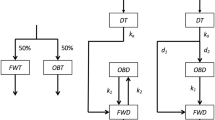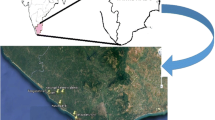Abstract
The intake and tissue distribution of thorium (2 3 2Th) was studied in an urban (Bombay) population in India. From the analysis of 16 whole diet samples, the average daily intake through food was found to be 2 μg (range 0.8–4.3 μg·d−1). The estimated intake through drinking water and inhalation comes out to be 0.03 and 0.02 μg per day. From the analysis of human autopsy tissue samples it is observed that the concentration ranges in lungs and bone are 1.5–16 μg/kg and 0.2–9.0 μg/kg fresh weight respectively. The average urinary concentration is 12 ng/1 (range 7–22 ng/l for 10 samples). Among the different body tissues, pulmonary lymph nodes were found to contain the highest concentration (geometric mean 53.4 μg/kg, range 31.4–85.5 μg/kg for 6 samples). Analysis of the samples was done by the neutron activation technique. 311.8 keV gamma photons of2 3 3Pa which is the activation product of2 3 2Th, were counted after chemical separation. A 54 cm3 intrinsic Ge detector coupled to 1024-channel analyser was used. Using the average lung content and the daily average intake values of thorium through inhalation, the clearance half-time from lung was estimated.
Similar content being viewed by others
References
International Commission on Radiological Protection, Limits for Intakes of Radionuclides by Workers, ICRP Publication 30, New York, Pergamon Press, 1979.
R. G. THOMAS, J. W. HEALY, J. F. McINROY, Health Phys., 46 (1984) 839.
D. D. JAISWAL, H. S. DANG and C. M. SUNTA, J. Radioanal. Nucl. Chem., 88 (1985) 225.
United Nations Scientific Committee on Effects of Atomic Radiation, (UNSCEAR), Ionizing Radiations Sources and Biological Effects, Report to the General Assembly, 1982, p. 93.
M. E. WREN, N. P. SINGH, N. COHEN, S. A. IBRAHIM, G. SACCOMANNO, NUREG/Cr-1227, New York University Medical Centre, 1981.
M. PICER, P. STROHAL, Anal. Chim. Acta, 40 (1968) 131.
C. W. SILL, C. P. WILLIS, Anal. Chem., 36 (1964), 622.
E. I. HAMILTON, M. J. MINSKY, J. J. CLEARY, Science of Total Environment, 1 (1972) 341.
O. R. HILL Health Phys., 8 (1962) 17.
H. Al-SHAHRISTANI, K. M. SHIBAB, M. JALIL, Proc. IAEA Symp. Nuclear Activation Technique in Life Sciences, Vienna, 1978, p. 515.
International Commission on Radiological Protection, 1974, Report of the Task Group on Reference Man, ICRP Publication-23 Pergamon Press, Oxford
H. F. LUCAS, D. N. EDINGTON, F. MARKUN, Health Phys., 19 (1970) 739
Author information
Authors and Affiliations
Rights and permissions
About this article
Cite this article
Sunta, C.M., Dang, H.S. & Jaiswal, D.D. Thorium in man and environment uptake and clearance. Journal of Radioanalytical and Nuclear Chemistry, Articles 115, 149–158 (1987). https://doi.org/10.1007/BF02041983
Received:
Issue Date:
DOI: https://doi.org/10.1007/BF02041983




